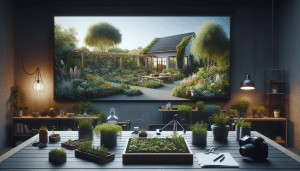Discover Why Raised Bed Gardening Transforms Yards
Daniel Fisher September 1, 2025
Unlock the secrets of creating a thriving home garden with raised bed gardening. This guide dives into how raised beds improve soil, simplify maintenance, help pest control, and boost yields for anyone hoping for a beautiful, productive backyard.
Why Raised Bed Gardening Appeals to Homeowners
Raised bed gardening intrigues homeowners seeking a reliable, productive way to grow vegetables, herbs, and flowers. Elevated soil beds enable control over garden conditions, separating plants from native ground soil. This approach appeals because it helps sidestep common yard issues like compacted or contaminated earth. By lifting the soil, drainage improves, and roots gain easier access to air, nutrients, and water—key factors for lush plant growth. Homeowners often find that a raised garden bed is the ideal canvas for experimenting with different crops, enjoying blooms nearly year-round, and creating a neat, organized look in their outdoor space.
One important reason people choose raised beds is the ease of maintenance compared to traditional gardens. Since beds are often at waist height, tending them reduces the need for bending or kneeling. This change can make gardening accessible for all ages and abilities. Mulching and weeding become simpler. The organized structure gives gardeners a way to separate different plant types to prevent crowding, manage sunlight, and experiment with companion planting techniques. Some families set aside spaces for children to grow their own plants, inspiring learning and responsibility through hands-on gardening activities (Source: https://extension.psu.edu/raised-bed-gardens).
The visual appeal of raised beds adds another layer of satisfaction. Wooden boxes, stone walls, or even recycled materials can be used for the bed edges, allowing for customized shapes and styles to match any landscape theme. Designing raised beds with creative shapes and staggered heights can elevate a yard’s appearance, set boundaries, and maximize limited outdoor space. This versatility often translates to higher property value and greater enjoyment of the outdoor environment, all while providing a practical approach to sustainable gardening at home.
Soil Quality and Structure Enhanced by Raised Beds
Soil quality is a frequent concern for gardeners. With raised beds, soil can be tailored and improved far more easily than amending native ground. Organic matter and compost mix readily to create a nutrient-dense, fluffy growing medium. The ability to select the right soil blend ensures plants aren’t stunted by rocky or clay-heavy earth, which is especially common in suburban yards. The loose soil profile encourages robust root systems and helps seeds germinate quickly. Better aeration means less risk of waterlogging and fewer root diseases—giving plants the start they need to thrive (Source: https://www.gardeningknowhow.com/edible/vegetables/vgen/raised-bed-soil-mix.htm).
Controlling soil composition lets gardeners address plants’ unique nutrient requirements. Adding specific amendments, like composted manure, bone meal, or peat moss, targets different crop needs and corrects deficiencies quickly. The top-down building approach to layering soil, compost, and organic matter also increases microbial activity. Healthy microbes and earthworms improve plant health and naturally recycle nutrients within the bed. It’s an organic cycle that results in higher yields and better-tasting produce from the backyard harvest.
Raised beds have another major advantage: less compaction. Because you don’t walk on the planting soil, roots remain uncrushed, and water moves through with ease. Reduced compaction ensures air, minerals, and moisture reach root zones efficiently. This means carrots grow longer, potatoes develop better, and leafy greens are less likely to wilt. With a shallow footprint and fluffy structure, the soil stays productive and lively season after season, making it easier to rotate crops and maintain fertility without much outside intervention.
Pest and Weed Management Becomes Simpler
Gardeners constantly battle weeds and pests, but raised beds offer strategic ways to lessen this struggle. By limiting exposed ground, fewer weed seeds blow in, and a thick mulch layer on top of the bed prevents most new growth. The contained space makes weeding a quick, manageable task, not a weekend-long chore. Some gardeners even install weed barriers at the bottom of the beds, further suppressing unwanted intruders. This structured environment also means fewer opportunities for invasive grass and persistent weed roots to take hold.
Pest control is also easier in elevated beds. The height acts as a partial barrier, making it harder for crawling insects, slugs, and small animals like rabbits to access crops. Many gardeners use physical covers, mesh netting, or even DIY hoop houses to protect sensitive plants from birds and bugs. Companion planting—choosing herbs or flowers that repel unwanted insects—is simpler in this controlled space. Combining marigolds with veggies, mixing aromatic herbs like basil near tomatoes, or placing nasturtiums near beans can naturally dissuade pests while adding color and diversity to the garden (Source: https://extension.umn.edu/yard-and-garden-news/companion-planting-vegetable-gardens).
For communities struggling with burrowing pests such as moles, voles, or even neighborhood cats, raised beds present an opportunity to block entry. Installing hardware cloth or strong mesh at the base during bed construction prevents underground intruders from disturbing roots or uprooting bulbs. When layered with mulch and organic matter, the bed effectively stays protected. These practical, low-intervention solutions make gardening in urban and suburban areas possible, even for those who have experienced repeated frustration with ground-level plots.
Space Usage, Watering, and Seasonal Flexibility in Home Gardens
Gardeners with limited yards or poor-quality land often turn to raised beds to maximize every available square foot. Plant spacing can be tailored for dense or intensive gardening, making it easy to mix leafy greens, root vegetables, and flowers without worry. Vertical trellises attached to bed edges allow crops like peas and beans to climb upward, freeing up ground for bushier varieties. Careful planning means even small suburban yards or patios can produce surprisingly large harvests (Source: https://ag.umass.edu/home-lawn-garden/fact-sheets/raised-bed-gardening).
Maintaining soil moisture is a core concern for successful growing. Raised beds drain well, but this means regular watering, especially during hot spells. Drip irrigation systems or soaker hoses laid along the soil surface can deliver moisture directly to roots, conserving water and reducing the risk of leaf diseases. Using mulch—such as straw, wood chips, or compost—helps slow evaporation, keeps roots cool, and suppresses remaining weeds. These steps streamline irrigation routines and help gardeners manage water resources efficiently, which is growing in importance for sustainable home landscapes.
Seasonal transitions are also more manageable in raised beds. The soil warms up faster in spring, allowing earlier planting of cold-hardy crops. In fall, flexible row covers protect tender plants against frost, extending the productive gardening season well beyond the first chilly nights. Some gardeners even use low tunnels or cold frames for winter greens or early radishes. This adaptability makes raised beds appealing to those who like to experiment or hope to keep fresh produce on the table for much of the year.
Design Inspirations and Material Choices for Every Space
From rustic wood boxes to sleek metal options and eco-friendly composites, raised garden beds can suit any style. Gardeners might use cedar for its rot resistance and earthy look or repurpose bricks and stones for a cottage garden vibe. Creative upcycling—like turning old stock tanks or unused furniture into planters—offers budget-friendly and sustainable solutions. Edge materials influence how the bed looks, how long it lasts, and what maintenance it will need over time.
The flexibility in shape and arrangement invites experimentation. Narrow beds lining a walkway work for herbs and flowers, while large rectangles accommodate sprawling squash or pumpkins. Stacking beds vertically adds dimension and increases growing space on small properties. Some gardeners design their beds around accessibility, with wide aisles for wheelbarrows or wheelchair-friendly heights (Source: https://www.rhs.org.uk/preparing-soil/raised-beds).
Drainage and durability are top considerations when choosing building materials and construction techniques. Beds can be lined with landscape fabric to slow soil loss and add extra weed protection. Adding a gravel or sand base promotes drainage, keeping plant roots healthy even after heavy rain. With a little planning, it’s easy to build raised beds that not only make gardening simpler but bring beauty, function, and value to outdoor living areas.
Benefits Beyond the Backyard: Raised Bed Gardens and Community Impact
While the benefits of raised beds in home gardens are clear, they’re increasingly found in schools, community gardens, and shared green spaces. The controlled growing environment ensures success, even for novice gardeners or those with mobility limitations. Community plots built as raised beds foster educational opportunities, foster collaboration, and give people a higher chance of producing food where resources are scarce. This gardening style helps connect neighbors, teach children, and improve food security (Source: https://www.jhsph.edu/research/centers-and-institutes/johns-hopkins-center-for-a-livable-future/projects/community-greening/).
Raised beds also support sustainability goals. They encourage composting, reduce reliance on synthetic fertilizers, and make efficient use of water. Restoring pollinator habitats, reducing lawn area, and integrating native plants into raised beds broaden positive ecological impact. The appeal isn’t confined to food production—flowering beds support bees and butterflies, enriching the local landscape.
Ultimately, starting a raised bed garden can inspire a transformative connection to nature. Whether used for food, flowers, or as shared learning grounds, these gardens foster well-being, beauty, and environmental stewardship. With careful planning, the rewards extend well beyond the fence line, building greener homes and healthier communities for everyone involved.
References
1. Penn State Extension. (n.d.). Raised Bed Gardens. Retrieved from https://extension.psu.edu/raised-bed-gardens
2. Gardening Know How. (n.d.). Raised Bed Soil Mix: Soil for Raised Bed Gardens. Retrieved from https://www.gardeningknowhow.com/edible/vegetables/vgen/raised-bed-soil-mix.htm
3. University of Minnesota Extension. (n.d.). Companion Planting for Vegetable Gardens. Retrieved from https://extension.umn.edu/yard-and-garden-news/companion-planting-vegetable-gardens
4. UMass Extension. (n.d.). Raised Bed Gardening. Retrieved from https://ag.umass.edu/home-lawn-garden/fact-sheets/raised-bed-gardening
5. Royal Horticultural Society. (n.d.). Raised Beds. Retrieved from https://www.rhs.org.uk/preparing-soil/raised-beds
6. Johns Hopkins Center for a Livable Future. (n.d.). Community Greening. Retrieved from https://www.jhsph.edu/research/centers-and-institutes/johns-hopkins-center-for-a-livable-future/projects/community-greening/








